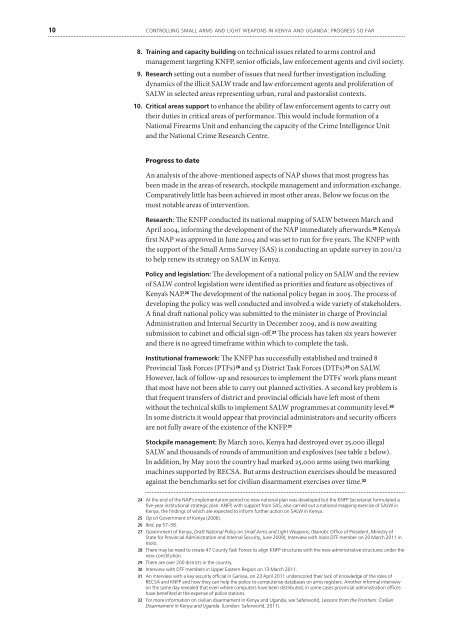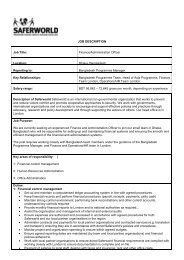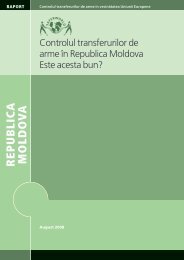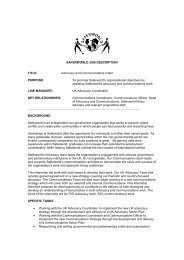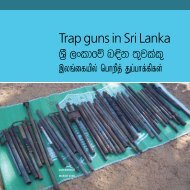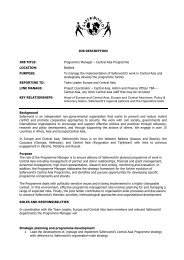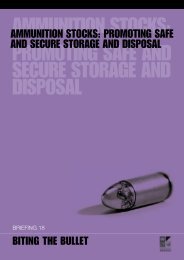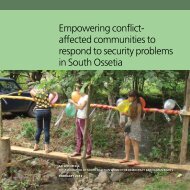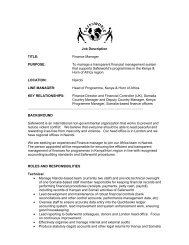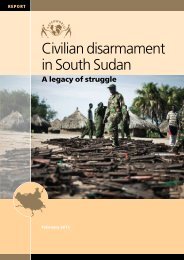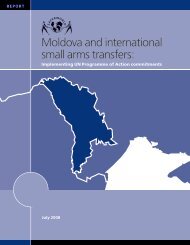Controlling small arms and light weapons in Kenya and ... - Saferworld
Controlling small arms and light weapons in Kenya and ... - Saferworld
Controlling small arms and light weapons in Kenya and ... - Saferworld
Create successful ePaper yourself
Turn your PDF publications into a flip-book with our unique Google optimized e-Paper software.
10 c o n t r o l l i n g s m a l l a r m s a n d l i g h t w e a p o n s <strong>in</strong> k e n y a a n d u g a n d a : p ro g re s s s o f a r8. Tra<strong>in</strong><strong>in</strong>g <strong>and</strong> capacity build<strong>in</strong>g on technical issues related to <strong>arms</strong> control <strong>and</strong>management target<strong>in</strong>g KNFP, senior officials, law enforcement agents <strong>and</strong> civil society.9. Research sett<strong>in</strong>g out a number of issues that need further <strong>in</strong>vestigation <strong>in</strong>clud<strong>in</strong>gdynamics of the illicit SALW trade <strong>and</strong> law enforcement agents <strong>and</strong> proliferation ofSALW <strong>in</strong> selected areas represent<strong>in</strong>g urban, rural <strong>and</strong> pastoralist contexts.10. Critical areas support to enhance the ability of law enforcement agents to carry outtheir duties <strong>in</strong> critical areas of performance. This would <strong>in</strong>clude formation of aNational Fire<strong>arms</strong> Unit <strong>and</strong> enhanc<strong>in</strong>g the capacity of the Crime Intelligence Unit<strong>and</strong> the National Crime Research Centre.Progress to dateAn analysis of the above-mentioned aspects of NAP shows that most progress hasbeen made <strong>in</strong> the areas of research, stockpile management <strong>and</strong> <strong>in</strong>formation exchange.Comparatively little has been achieved <strong>in</strong> most other areas. Below we focus on themost notable areas of <strong>in</strong>tervention.Research: The KNFP conducted its national mapp<strong>in</strong>g of SALW between March <strong>and</strong>April 2004, <strong>in</strong>form<strong>in</strong>g the development of the NAP immediately afterwards. 25 <strong>Kenya</strong>’sfirst NAP was approved <strong>in</strong> June 2004 <strong>and</strong> was set to run for five years. The KNFP withthe support of the Small Arms Survey (SAS) is conduct<strong>in</strong>g an update survey <strong>in</strong> 2011/12to help renew its strategy on SALW <strong>in</strong> <strong>Kenya</strong>.Policy <strong>and</strong> legislation: The development of a national policy on SALW <strong>and</strong> the reviewof SALW control legislation were identified as priorities <strong>and</strong> feature as objectives of<strong>Kenya</strong>’s NAP. 26 The development of the national policy began <strong>in</strong> 2005. The process ofdevelop<strong>in</strong>g the policy was well conducted <strong>and</strong> <strong>in</strong>volved a wide variety of stakeholders.A f<strong>in</strong>al draft national policy was submitted to the m<strong>in</strong>ister <strong>in</strong> charge of Prov<strong>in</strong>cialAdm<strong>in</strong>istration <strong>and</strong> Internal Security <strong>in</strong> December 2009, <strong>and</strong> is now await<strong>in</strong>gsubmission to cab<strong>in</strong>et <strong>and</strong> official sign-off. 27 The process has taken six years however<strong>and</strong> there is no agreed timeframe with<strong>in</strong> which to complete the task.Institutional framework: The KNFP has successfully established <strong>and</strong> tra<strong>in</strong>ed 8Prov<strong>in</strong>cial Task Forces (PTFs) 28 <strong>and</strong> 53 District Task Forces (DTFs) 29 on SALW.However, lack of follow-up <strong>and</strong> resources to implement the DTFs’ work plans meantthat most have not been able to carry out planned activities. A second key problem isthat frequent transfers of district <strong>and</strong> prov<strong>in</strong>cial officials have left most of themwithout the technical skills to implement SALW programmes at community level. 30In some districts it would appear that prov<strong>in</strong>cial adm<strong>in</strong>istrators <strong>and</strong> security officersare not fully aware of the existence of the KNFP. 31Stockpile management: By March 2010, <strong>Kenya</strong> had destroyed over 25,000 illegalSALW <strong>and</strong> thous<strong>and</strong>s of rounds of ammunition <strong>and</strong> explosives (see table 2 below).In addition, by May 2010 the country had marked 25,000 <strong>arms</strong> us<strong>in</strong>g two mark<strong>in</strong>gmach<strong>in</strong>es supported by RECSA. But <strong>arms</strong> destruction exercises should be measuredaga<strong>in</strong>st the benchmarks set for civilian disarmament exercises over time. 3224 At the end of the NAP’s implementation period no new national plan was developed but the KNFP Secretariat formulated afive-year <strong>in</strong>stitutional strategic plan. KNFP, with support from SAS, also carried out a national mapp<strong>in</strong>g exercise of SALW <strong>in</strong><strong>Kenya</strong>, the f<strong>in</strong>d<strong>in</strong>gs of which are expected to <strong>in</strong>form further action on SALW <strong>in</strong> <strong>Kenya</strong>.25 Op cit Government of <strong>Kenya</strong> (2006).26 Ibid, pp 57–58.27 Government of <strong>Kenya</strong>, Draft National Policy on Small Arms <strong>and</strong> Light Weapons, (Nairobi: Office of President, M<strong>in</strong>istry ofState for Prov<strong>in</strong>cial Adm<strong>in</strong>istration <strong>and</strong> Internal Security, June 2009); Interview with Isiolo DTF member on 20 March 2011 <strong>in</strong>Isiolo.28 There may be need to create 47 County Task Forces to align KNFP structures with the new adm<strong>in</strong>istrative structures under thenew constitution.29 There are over 200 districts <strong>in</strong> the country.30 Interview with DTF members <strong>in</strong> Upper Eastern Region on 13 March 2011.31 An <strong>in</strong>terview with a key security official <strong>in</strong> Garissa, on 23 April 2011 underscored their lack of knowledge of the roles ofRECSA <strong>and</strong> KNFP <strong>and</strong> how they can help the police to computerise databases on <strong>arms</strong> registers. Another <strong>in</strong>formal <strong>in</strong>terviewon the same day revealed that even where computers have been distributed, <strong>in</strong> some cases prov<strong>in</strong>cial adm<strong>in</strong>istration officeshave benefited at the expense of police stations.32 For more <strong>in</strong>formation on civilian disarmament <strong>in</strong> <strong>Kenya</strong> <strong>and</strong> Ug<strong>and</strong>a, see <strong>Saferworld</strong>, Lessons from the Frontiers: CivilianDisarmament <strong>in</strong> <strong>Kenya</strong> <strong>and</strong> Ug<strong>and</strong>a. (London: <strong>Saferworld</strong>, 2011).


